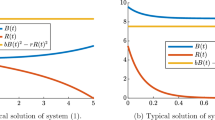Abstract
During the first World War, F. W. Lanchester outlined several tentative mathematical models of the fledgling art of air warfare [9], [10]. These models have since been extended to represent a variety of competitions ranging from isolated battles to entire wars. We shall outline and “solve” some simple models, commenting on a mixed conventional-guerrilla combat such as Vietnam and studying in some depth the battle of Iwo Jima during World War II.
Satietie of sleepe and love, satietie of ease, Of musicke, can find place, yet harsh warre still must please Past all these pleasures, even past these1.
Access this chapter
Tax calculation will be finalised at checkout
Purchases are for personal use only
Preview
Unable to display preview. Download preview PDF.
Similar content being viewed by others
Reference
M. Braun, Differential Equations and Their Applications, 2nd ed. New York: Springer-Verlag, 1978. The best book around on the elementary level. Braun introduces Richardson’s theory [13] of the arms race on pp. 513–525.
S. J. Deitchman, “A Lanchester model of guerrilla warfare,” Operations Res., vol. 10, pp. 818–827, 1962. A readable account of the topic with a brief introduction to Lanchester’s laws.
J. H. Engel, “A verification of Lanchester’s law,” Operations Res. (J. Operations Res.Soc. Amer.), vol. 2, pp. 163–171, 1954. The source of our analysis of the battle of Iwo Jima. Should be accessible to the undergraduate.
G. W. Garand and T. R. Strobridge, History of United States Marine Corps Operations in World War II, vol. 4 [Western Pacific Operations], Histor. Div. Hdqr. USMC, 1971. An extensive treatment of the planning and execution of the Iwo Jima operation. No mathematics at all.
G. H. Hardy, A Mathematician’s Apology, 2nd ed. New York: Cambridge Univ. Press, 1967, pp. 140–141. From the book jacket: “… a personal account by a distinguished mathematician of what mathematics meant to him as a man. Hardy discusses and illustrates the attractive force of mathematics. He dismisses its utility but describes its depth and beauty as a creative art.”
Homer, The Iliad, G. Chapman, tr. New York: Pantheon Books, 1956, V.1. The lines quoted are from Book XIII, lines 571–575.
G. J. Hueter, M. A. McClelland, L. A. Resner and M. G. Zevallos, “An application of the Lanchester model to the battle of the Ardennes,” Interface vol. 5, no. 1, pp. 15–26, 1978. Available from Department of Mathematics, Harvey Mudd College, Claremont, CA 91711.
D. R. Howes and R. M. Thrall, “A theory of ideal linear weights for heterogeneous combat forces,” Naval Res.Logistics Quart., vol. 20, pp. 645–659, 1973. We have considered only homogeneous forces; Howes and Thrall take up the more realistic heterogeneous case using the techniques of linear algebra. Accessible to students at the end of a linear algebra course. Good bibliography.
F. W. Lanchester, Aircraft in Warfare; The Dawn of the Fourth Arm. Constable and Co., Ltd., 1916. This book is hard to find now but is the basic source.
F. W. Lanchester, “Mathematics in warfare,” in The World of Mathematics, vol. 4, J. R. Newman, Ed. New York: Simon and Schuster, 1956, pp. 2138–2157. This article is taken from Lanchester’s book and is a readable introduction to his simplest models. Lanchester relates heterogeneous forces to the Pythagorean theorem!
C. P. Morehouse, The Iwo Jima Operation, Histor. Div. Hdqr. USMC, 1946. Contains the daily American casualty lists for the battle; book is hard to find.
R. F. Newcomb, Iwo Jima. New York: Holt, Rinehart, and Winston, 1965. A fairly complete account of the battle; shorter than Garand and Strobridge (and not as incisive), not mathematical.
L. R. Richardson, “Mathematics of war and foreign politics,” in The World of Mathematics, vol. 4, J. R. Newman, Ed. New York: Simon and Schuster, 1956, pp. 1240–1253. Richardson was a physicist with a Quaker background whose aversion to war led him to make a serious study of its causes. In this very readable essay he uses differential equations to model the arms race. (See also Braun [1].)
H. K. Weiss, “Lanchester-type models of warfare,” Proc. 1st Internat. Congr. on Operations Research, Baltimore, MD 1957, pp. 82–99. A good survey of the basic models and some of their extensions.
Author information
Authors and Affiliations
Editor information
Editors and Affiliations
Rights and permissions
Copyright information
© 1983 Springer-Verlag New York Inc.
About this chapter
Cite this chapter
Coleman, C.S. (1983). Combat Models. In: Braun, M., Coleman, C.S., Drew, D.A. (eds) Differential Equation Models. Modules in Applied Mathematics. Springer, New York, NY. https://doi.org/10.1007/978-1-4612-5427-0_8
Download citation
DOI: https://doi.org/10.1007/978-1-4612-5427-0_8
Publisher Name: Springer, New York, NY
Print ISBN: 978-1-4612-5429-4
Online ISBN: 978-1-4612-5427-0
eBook Packages: Springer Book Archive




